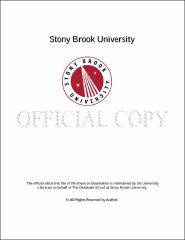| dc.identifier.uri | http://hdl.handle.net/11401/76450 | |
| dc.description.sponsorship | This work is sponsored by the Stony Brook University Graduate School in compliance with the requirements for completion of degree. | en_US |
| dc.format | Monograph | |
| dc.format.medium | Electronic Resource | en_US |
| dc.language.iso | en_US | |
| dc.publisher | The Graduate School, Stony Brook University: Stony Brook, NY. | |
| dc.type | Thesis | |
| dcterms.abstract | The Two-Phase Closed Thermosyphon (TPCT) is a device that transfers heat from its bottom to top and because phase change phenomenon happens both in its bottom and top, its performance is ten times better than pure metal. It has three heat transfer regimes, condenser, adiabatic section and evaporator. The mechanism of thermosyphon is the phase change cycle: liquid absorbs heat in evaporator and then vaporizes into vapor; finally the vapor condenses along the condenser wall and flow back to evaporator liquid pool. Firstly, detailed heat transfer mechanism will be discussed. Many empirical equations will be reviewed. Geometrically, TPCT contains three parts, condenser, adiabatic section and evaporator, and each of them has three possible mechanism, natural convection, nucleate boiling and transit convection between these two. In evaporator, it contains both film and pool area. Thus, comprehensively heat transfer mechanism literature review is needed and it is the preparation for building model. A numerical model is built from basic governing equations and empirical equations. It is suitable for any kind of liquids and covers wide range of geometry size and power input. With this model, important TPCT parameters, such as filling ratio, power input, pipe diameter, and so on, are researched theoretically. An experiment system is built up. Through this, power input and working fluids filling ratio are controlled based on need. Temperature along outer pipe wall and vapor pressure are collected by this system. Lots of experiment data about methanol and ethanol are listed in figures and charts. Comparison between simulation and experiment is conducted. Creatively, new fluids are applied in this project. Experiment data about aluminum oxide nanofluids, ethanol-water azeotrope and ethanol-methanol mixture are listed. | |
| dcterms.available | 2017-09-20T16:50:18Z | |
| dcterms.contributor | Longtin, Jon | en_US |
| dcterms.contributor | Longtin, Jon P | en_US |
| dcterms.contributor | Hwang, David | en_US |
| dcterms.contributor | Kincaid, John. | en_US |
| dcterms.creator | Mei, Chunlei | |
| dcterms.dateAccepted | 2017-09-20T16:50:18Z | |
| dcterms.dateSubmitted | 2017-09-20T16:50:18Z | |
| dcterms.description | Department of Mechanical Engineering. | en_US |
| dcterms.extent | 80 pg. | en_US |
| dcterms.format | Monograph | |
| dcterms.format | Application/PDF | en_US |
| dcterms.identifier | http://hdl.handle.net/11401/76450 | |
| dcterms.issued | 2013-12-01 | |
| dcterms.language | en_US | |
| dcterms.provenance | Made available in DSpace on 2017-09-20T16:50:18Z (GMT). No. of bitstreams: 1
Mei_grad.sunysb_0771M_11389.pdf: 1760217 bytes, checksum: dca35398440acbbfa61c7e88edc3a257 (MD5)
Previous issue date: 1 | en |
| dcterms.publisher | The Graduate School, Stony Brook University: Stony Brook, NY. | |
| dcterms.subject | Mechanical engineering | |
| dcterms.subject | Azeotrope, Experiment, Minimum temperature difference, Modeling, Nanofluids, Thermosyphon | |
| dcterms.title | High Performance Two-Phase Thermosyphon for Energy-Efficient Refrigeration Applications: Modeling and Experiments | |
| dcterms.type | Thesis | |

